
Apocynaceae is a family of flowering plants that includes trees, shrubs, herbs, stem succulents, and vines, commonly known as the dogbane family, because some taxa were used as dog poison. Members of the family are native to the European, Asian, African, Australian, and American tropics or subtropics, with some temperate members. The former family Asclepiadaceae is considered a subfamily of Apocynaceae and contains 348 genera. A list of Apocynaceae genera may be found here.

According to APG II, the Asclepiadaceae, commonly known as milkweed family, is a former plant family now treated as a subfamily in the Apocynaceae.

Asclepias is a genus of herbaceous, perennial, flowering plants known as milkweeds, named for their latex, a milky substance containing cardiac glycosides termed cardenolides, exuded where cells are damaged. Most species are toxic to humans and many other species, primarily due to the presence of cardenolides, although, as with many such plants, there are species that feed upon them and from them. The genus contains over 200 species distributed broadly across Africa, North America, and South America. It previously belonged to the family Asclepiadaceae, which is now classified as the subfamily Asclepiadoideae of the dogbane family, Apocynaceae.

Lespedeza is a genus of some 40 species of flowering plants in the pea family (Fabaceae), commonly known as bush clovers or Japanese clovers (hagi). The genus is native to warm temperate to subtropical regions of eastern North America, eastern and southern Asia and Australasia.
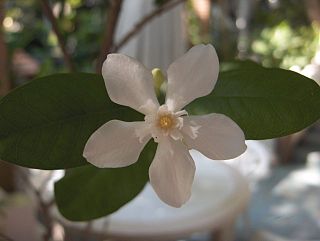
Wrightia is a genus of flowering plants in the family Apocynaceae, first described as a genus in 1810. It native to tropical Africa, China, the Indian Subcontinent, Southeast Asia, Papuasia, and Australia. The species are all small trees or shrubs.

Asclepias curassavica, commonly known as tropical milkweed, is a flowering plant species of the milkweed genus, Asclepias. It is native to the American tropics and has a pantropical distribution as an introduced species. Other common names include bloodflower or blood flower, cotton bush, hierba de la cucaracha, Mexican butterfly weed, redhead, scarlet milkweed, and wild ipecacuanha.

Holostemma is a genus of flowering plants in the family Apocynaceae. The genus was first described in 1810. As presently constituted, the genus contains only one known species, Holostemma ada-kodien, native to southern Asia.
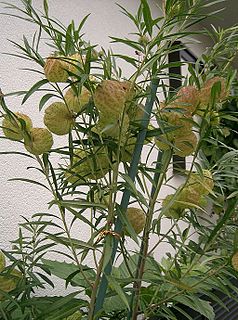
Gomphocarpus physocarpus, commonly known as hairy balls, balloonplant, balloon cotton-bush, bishop's balls, nailhead, or swan plant, is a species of milkweed. The plant is native to southeast Africa, but it has been widely naturalized. It is often used as an ornamental plant.
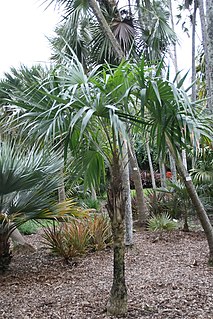
Schippia concolor, the mountain pimento or silver pimeto, is a medium-sized palm species that is native to Belize and Guatemala. Named for its discoverer, Australian botanist William A. Schipp, the species is threatened by habitat loss. It is the sole species in the genus Schippia.

Sarcostemma is a genus of flowering plants in the dogbane family, Apocynaceae, first described as a genus in 1810. The name is derived from the Greek words σαρκὸς (sarkos), meaning "flesh," and στέμμα (stemma), meaning "garland". Members of the genus are known generally as climbing milkweeds or caustic bushes. They are found across Africa and tropical Asia, in Australia, and in parts of North America. These plants are perennial flowering shrubs with trailing vines or lianas. They are often adapted to heat and/or desert conditions. Some have few or no leaves and photosynthesize in the tissues of the green stems. The soft stems are filled with a milky white latex that is poisonous and caustic in some species. The flowers have a ring of thick tissue at the base which extends into hollow spherical appendages within the flower corolla.

Diplolepis is a plant genus in the family Apocynaceae, first described as a genus in 1810. It is native to southern South America.
- Diplolepis boerhaviifolia - Chile
- Diplolepis descolei - Argentina
- Diplolepis geminiflora - Chile
- Diplolepis hieronymi - Argentina
- Diplolepis menziesii - Chile
- Diplolepis nummulariifolia - Chile
- D. apiculata, syn of Tylophora hirsuta
- D. longirostrum, syn of Cynanchum longirostrum
- D. ovata, syn of Tylophora ovata
- D. variabilis, syn of Cynanchum atacamense
- D. vomitoria, syn of Tylophora asthmatica
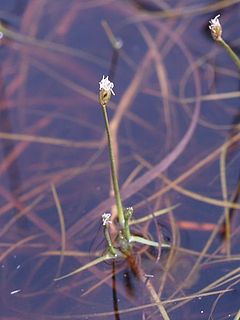
Isolepis fluitans, commonly known as floating scirpus, is a species of flowering plant in the sedge family. It is native to Africa, Australasia, Europe, and Pacific. It was first described by Carl Linnaeus in 1753, and later transferred to Isolepis by the botanist Robert Brown in 1810.

Gomphocarpus is a genus of plants in the family Apocynaceae first described as a genus in 1810. It is widespread across much of Africa, with a few species naturalized in other regions.

Hemidesmus is a genus of plants in the Apocynaceae, first described in 1810. It is native to the Indian Subcontinent.
- Hemidesmus cordatus(Poir.) Schult. - India
- Hemidesmus indicus(L.) R. Br. ex Schult. - Pakistan, India, Bangladesh
- Hemidesmus indicus var. pubescensHook.f., syn of Finlaysonia wallichii(Wight) Venter
- Hemidesmus pubescensWight & Arn., syn of Finlaysonia wallichii(Wight) Venter
- Hemidesmus wallichiiWight, syn of Finlaysonia wallichii(Wight) Venter

Stenostelma is a genus of plants in the family Apocynaceae, first described as a genus in 1894. It is native to South Africa.
- Stenostelma capenseSchltr. - Northern Cape Province
- Stenostelma carinatum(Schltr.) Bullock - KwaZulu-Natal
- Stenostelma corniculatum(E. Mey.) Bullock - Eastern Cape Province
- Stenostelma umbelluliferum(Schltr.) Bester & Nicholas - Gauteng Province
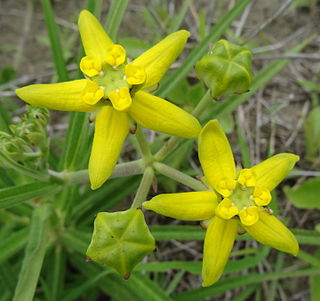
Stathmostelma is a genus of plants in the family Apocynaceae, first described as a genus in 1893. It is native to Africa.
Glossostelma is a plant genus in the family Apocynaceae, first described as a genus in 1895. It is native to Africa.
- Glossostelma angolenseSchltr. - Angola
- Glossostelma brevilobumGoyder - Zaïre, Burundi, Tanzania, Malawi
- Glossostelma cabrae(De Wild.) Goyder - Zaïre
- Glossostelma carsonii(N.E.Br.) Bullock - Gabon
- Glossostelma ceciliae(N.E.Br.) Goyder - Zimbabwe, Mozambique
- Glossostelma erectum(De Wild.) Goyder - Zaïre
- Glossostelma lisianthoides(Decne.) Bullock - Angola
- Glossostelma mbisienseGoyder - Tanzania
- Glossostelma nyikenseGoyder - Malawi, Zambia
- Glossostelma rusapenseGoyder - Zimbabwe
- Glossostelma spathulatum(K.Schum.) Bullock - Angola
- Glossostelma xysmalobioides(S.Moore) Bullock - Angola

Pachycarpus is a genus of plants in the family Apocynaceae, first described in 1838. It is native to Africa.
















